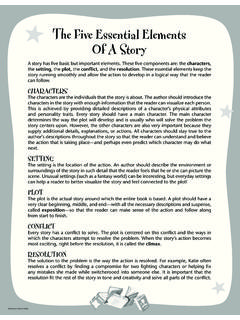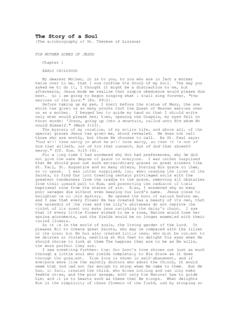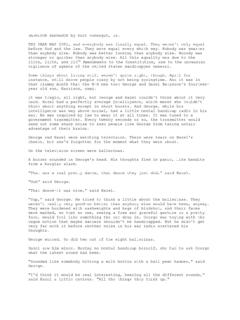Transcription of Theories of Story and Storytelling
1 Theories of Story and Storytelling by Eric Miller, PhD January 2011 This piece of writing asks, and begins to answer, such questions as: What is a Story ? How can Story and Storytelling be defined? What are the seven elements of a Story ? What are some types of stories? What makes stories and Storytelling great, entertaining, meaningful, and memorable? How have various scholars, psychologists, and cultures seen stories and Storytelling ? What are some functions of stories and Storytelling in individuals and in society? Story can be defined as, a series of events. Storytelling can be defined as, relating a series of events. Story and narrative mean the same thing. Narrative is simply a more academic term than Story . In a Story , causality is involved in some way (along the lines: A leads to B, B leads to C, C leads to D, etc).
2 Story and Storytelling can be considered as types of play. Anthropology of Play scholars have posited that three conditions to be satisfied for an activity to be considered as play, are that the activity is done in a special time in a special space just for fun Play presents a model of the past, and a model for the future. Two kinds of play are Art (which involves creating beauty through collaboration) Games (which involves rules and competition) Stories are pieces of art, and can serve as a basis of games. We can study how a Story is told/performed/presented (presentation analysis). And we can study the actual content of the Story (content analysis). A distinction can be made between actual Storytelling , and presenting a Story through other mediums. The difference is that in actual Storytelling , the tellers and listeners can give instantaneous and ongoing feedback to each other.
3 Even though making movies (or other recordings, or books) is not actual Storytelling , we often speak of cinematic storytellers. To be most verbally accurate, we might say that movie makers (and novelists, etc) are presenting a Story . It is debatable as to whether or not actual Storytelling occurs through mediated situations such as telephoning or videoconferencing. Some purists feel that for an event to be considered as actual Storytelling , the participants need to be physically present with each other. Nonetheless, as the level of interactivity in an electronically-mediated communication event increases (especially in terms of immediacy of feedback, and audio and video representation of participants), the event may become more Storytelling -ish. 2 Projection, Identification, Empathy, Imitation, and Imagination are important processes when it comes to people and stories.
4 People project themselves into Story characters. They identify with the characters. They feel empathy with the characters. This occurs through the use of the listener s imagination. The listener may then imitate the character. Each culture has traditional and conventional ways of signaling that a Story is beginning and ending. In English, one way is -- Once upon a time , and They lived happily ever after . Some storytellers like to comment upon, and tell the moral of, a Story . Others like to let the Story speak for itself, and permit listeners to generate their own interpretations and meanings. Storytellers often alternate between narrating a Story , and going into character (role-playing, speaking dialogue). speaking and singing. normal conversational speech and movement; and stylized (exaggerated, rhythmical, etc) speech and movement telling in the past tense, and in the present tense.
5 What are Some Uses of Stories? Stories can give meaning to life, express values, teach the young, and convey culture. connect elements in one s own self, experience, and life. connect one to one s (individual and group) past, and to other cultures. give one a sense of wholeness, that the pieces of one s life fit together and add up to something. What Makes a Storytelling Event Great, Entertaining, and Meaningful? Listeners are drawn in, and feel involved and engaged. They relate to the teller and to what is being told. They forget themselves, and get involved in the efforts, struggles, and behavioural styles of the characters. They put themselves in the place of the characters; they relate to characters situations and decisions, on the levels of feeling (emotion) and intellect (thought).
6 The Story is important to both teller and listeners. The style of telling is vivid and clear -- the design (of the form and content) of the Storytelling experience is in step with the times. 3 Dramatic Tension Dramatic tension results when audience members expect something to happen. Skilled storytellers know how to raise and manipulate such expectations. Some expectations are built into certain cultures, through conventions and traditions. Other expectations are universal to humans. Eleven Elements of Story Eleven elements of Story -- 1) Characters (decisions and follow-through). 2) Place. 3) Time (continuous, or jumps, flashbacks?) 4) Storyline (also known as, plot). 5) Sensory Elements: Smells, Flavours, Colours, Textures, etc. 6) Objects. Such as: Clothing.
7 A costume. A piece of fabric. 7) Characters' physical gestures, and attitudes. 8) Emotions in the Story (for the characters, the teller, and the listeners). 9) Narrator s Point of View. (Who is telling the Story ? Is the Story being told by a character in the Story ? Is it clear whom the intended audience might be?) 10) Narrator's Tone of Voice, Attitude, Style (casual, formal, other?). 11) Theme (Meaning, moral, message, idea). Elements 1-10 combined produce element 11. Moments of decision are crucial in stories, as in life. A character s nature is exposed (or self-created) through his/her decisions and actions. That is: A figure s character manifests and expresses itself in, is embodied in, his/her decisions and actions. These decisions and actions form important parts of the storyline, the plot.
8 Three Kinds of Stories Personal Experience stories Traditional stories Created stories. Created stories often involve a mix of elements from Personal Experience stories and Traditional stories. Regarding Personal Experience stories: Why do people remember and decide to share certain experiences? What events tend to be considered significant enough for one to make a Story out of them? Telling a Story involves expressing points of view -- that an event is significant, and how one feels about it. Thus telling a Story is an act of moral persuasion. If teller and listeners can agree that a Story is worth telling, and that it has a certain point and meaning -- they are members of a community together. Types of traditional stories include: Folktale Legend Epic Myth 4 Folktales tend to be timeless and placeless, with characters that are well-known in a culture.
9 One type of Folktale is a Fairytale -- Fairytales have a magical element. Legends are historical stories, which took place in a certain place, often in the distant past, with some divine element. Epics are long stories that tell of the adventures of heroes/heroines as they travel from one end of the land to the other. Epics tend to be encyclopedic, serving as compendiums of many aspects of a culture, and often end with the hero/heroine founding a new institution (even a nation). Myths are stories about divine characters. Myths often concern the creation of the physical world, and occur before human history. Storytellers sometimes bring out -- in characters, and in audience members -- mythic feelings in everyday life and experience. These categories (or genres) of Story were invented, it seems, in ancient Greece, and have been adopted by European and USA cultures.
10 Other categories of Story exist in other cultures. It is a good idea to always see what categories of Story exist in a culture, instead of imposing categories from the outside. People might benefit from inventing and/or developing their own Theories of Story (please see below). Personification (also known as Anthropomorphism) is am important tool of Storytelling . This involves projecting human characteristics and qualities -- such as thoughts, emotions, desires, sensations, physical gestures, and speech -- onto animals, other nonhuman beings, natural phenomena, inanimate objects, and even abstract ideas. The term, anthropomorphism, is derived from two Greek words: anthropos, meaning human; and morph, meaning shape or form. Another tool of Storytelling is to project aspects of contemporary life onto occurrences in earlier time periods.









